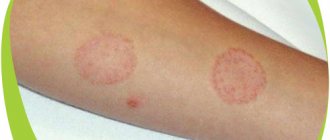Causes of measles
Measles is one of the most contagious diseases. The infection is transmitted by airborne droplets.
A person who is not immune to measles will almost certainly become ill when exposed to the infection, regardless of their age. In order to get sick, it is not necessary to have direct contact with a carrier of the infection; you can become infected, for example, by entering the room where he was recently located. There are known cases of the measles virus spreading over significant distances with air flow. But at the same time, the virus is not stable in the external environment; it quickly dies outside the human body from exposure to various chemical and physical factors (irradiation, boiling, treatment with disinfectants).
The incubation period of measles ranges from 7 to 14 days. The source of infection is a patient with measles in any form. The patient is contagious to others, starting from the last days of the incubation period (last 2 days) until the 4th day of the rash. From the 5th day of the rash, the patient is considered non-infectious.
Why measles is dangerous and how to protect yourself from it
Measles is an infectious disease that is characterized by general intoxication, high fever, damage to the mucous membranes of the eyes, respiratory tract, and is accompanied by a rash.
Every hour around the world, 15 people die from it, which amounts to 165,000 people a year. And before 1980, the number of deaths was 20 times greater! Mortality rates are particularly high in developing countries in Africa and Asia. There, 20% of child deaths are associated with measles. We managed to get rid of major measles epidemics thanks to universal vaccination. Children aged 1 and 6 years are vaccinated against measles, rubella and mumps. Even if vaccinated people get sick, they experience a mild form of the disease.
How can you get measles?
The causative agent of measles is a virus that is transmitted through airborne droplets by sneezing, coughing, talking, crying, screaming and breathing.
The source of infection is only a sick person, who is contagious to others from the last days of the incubation period (before the onset of symptoms of the disease), to the maximum extent during the period of catarrhal manifestations and to a lesser extent in the first days of the appearance of the rash.
The measles virus is highly volatile - it is transferred with air currents to other rooms, floors, etc. Therefore, measles infection is possible not only through close contact with a sick person, but also when staying in adjacent rooms.
Persons who have not had measles and are not vaccinated against this infection are highly susceptible to the disease. After contact with a sick person, in almost 100% of cases an unprotected person will become infected with measles.
What are the clinical signs of measles?
The incubation period averages from 9 to 17 days, with a maximum of 21 days. Clinical symptoms develop in stages: first, body temperature rises to 38-40°C, catarrhal manifestations are noted: runny nose, cough, hoarseness, the mucous membranes of the eyes are affected (conjunctivitis). A few days after the onset of illness, the main symptom of measles appears – a rash. Initially, the rash is noted on the face and neck, over the next 2 days it covers the limbs and torso. During the period of the appearance of the rash, all existing symptoms of the disease increase.
Why is measles dangerous?
Measles is dangerous due to the development of complications: from the respiratory system - pneumonia, laryngitis, laryngotracheitis, from the nervous system - meningitis, encephalitis, from the gastrointestinal tract - stomatitis, colitis, etc.
In adults, measles is especially severe. Pneumonia and bacterial complications are often associated with the underlying disease. Sometimes the disease can result in blindness and significant hearing loss.
One of the most dangerous complications of measles is viral meningoencephalitis (inflammation of the meninges), leading to death in 40% of cases. The measles virus greatly suppresses the immune system of an adult, as a result of which chronic diseases worsen and new ones are acquired.
What should you do if you have symptoms similar to measles?
- Seek medical help immediately (do not visit the clinic, but call a doctor or emergency medical team).
- Before visiting a doctor, if possible, exclude or minimize contact with relatives, friends and other people.
- When coughing and sneezing, cover your mouth with a tissue or tissue.
- Wash your hands often with soap and try not to touch your lips, nose and eyes.
- It is advisable to use personal respiratory protection (for example, a mask or gauze bandage).
- Do not self-medicate.
- Be sure to tell your doctor when and where you left the country or city.
How to protect yourself from measles?
The only reliable protection against measles is immunization.
In accordance with the National Calendar of Preventive Vaccinations, immunization against measles is carried out routinely for children aged 12 months and 6 years. In addition, vaccination is carried out according to epidemic indications for persons who have not been vaccinated against measles (if there is contact with a patient with measles).
How can you find out if you are vaccinated against measles?
You can clarify information about previously immunized against measles (including when planning trips to countries where cases of the disease are observed) at the health care institution (polyclinic) at the place of medical care.
If you have information about vaccinations against measles or information about past illness, immunization is not required.
The advisability of immunization against measles in each specific case is determined by the doctor.
Take timely care of your health and the health of your children. Vaccination is reliable protection against the disease.
Measles symptoms
The disease, if it develops in accordance with the typical picture, passes through three stages: catarrhal, the period of eruptions and the period of pigmentation.
In children under the age of one year, measles can occur in an erased form, since during this period the child has passive immunity received from the mother’s body.
Catarrhal stage
The onset of the disease is sudden, with symptoms reminiscent of a cold.
The temperature rises – up to 38-39°C. Headache, runny nose, conjunctivitis, dry and obsessive cough appear. Redness of the throat is observed, red spots appear on the hard and soft palate. The voice becomes hoarse. 1-2 days after the onset of the disease in the mouth, small whitish spots appear on the mucous membrane of the cheeks near the molars, surrounded by a narrow red border, slightly rising above the level of the mucous membrane. In appearance they resemble semolina or bran.
By the end of the first stage, the temperature decreases.
Period of rash
At the second stage (usually the 4th or 5th day of illness), the temperature rises again - up to 39-40 ° C and a rash appears: first on the face, neck, behind the ears. The next day - on the torso. On the 3rd day of the rash, the rash covers the extensor surfaces of the arms and legs, including the fingers. The rash has a dark red (purple) color, the elements of the rash merge. The affected skin becomes rough. The period of rash is the most severe stage of the disease.
On the fourth day after its appearance, the rash begins to fade away - in the same order as it appeared. The rash darkens, turns brown, becomes pigmented, peels off, and the temperature returns to normal.
Pigmentation period
Brown scaly spots at the site of the rash persist for another 1.5 weeks. This is the third stage of the disease - the period of pigmentation.
Diagnosis of the disease
Differential diagnosis
Measles should be differentiated from rubella, scarlet fever, pseudotuberculosis, allergic (drug-induced, etc.) dermatitis, enterovirus infections, serum sickness and other diseases accompanied by the appearance of skin rashes.
Measles is distinguished by a complex of main clinical manifestations in the catarrhal period: intoxication, runny nose with copious discharge, obsessive rough, “barking” cough, hoarseness, severe conjunctivitis with swelling of the eyelids, injection of scleral vessels and purulent discharge, photophobia, the appearance of a cardinal clinical diagnostic sign - Filatov’s spots -Koplik-Velsky on the 3-5th day of illness. Then a bright maculopapular exanthema appears, which tends to merge. A very important differential diagnostic feature characteristic of measles (with the exception of mitigated measles) is the descending sequence of rashes.
Laboratory diagnostics
In a hemogram for uncomplicated measles, leukopenia or normocytosis, a shift in the leukocyte count to the left, lymphocytosis, the appearance of plasma cells, and an increase in ESR are noted. In adults, neutrophilia, lymphopenia and aneosinophilia are possible. Isolation of the virus from nasopharyngeal swabs and the performance of serological tests (RTGA, RSK and RN in paired sera) are rarely used in clinical practice, since their results are retrospective.
Methods for diagnosing measles
In most cases, measles is diagnosed based on examination of the patient. However, in some cases additional research is required.
General blood analysis
A general blood test is a basic test for any infectious disease. In case of measles, the analysis will show a decrease in the level of lymphocytes, leukocytes, monocytes, neutrophils and eosinophils (the latter may be completely absent). The erythrocyte sedimentation rate (ESR) increases moderately.
More information about the diagnostic method
General urine analysis
A general urine test - another "mandatory minimum" test - will show leukocyturia (increased white blood cell levels), as well as protein in the urine.
More information about the diagnostic method
Serological blood test
A serological blood test is designed to detect IgM and IgG antibodies to the measles virus. This analysis allows us to establish that the body was attacked by this particular virus. IgG antibodies provide immunity to this disease, preventing you from getting measles again. They begin to be produced from the second day of the rash (or 10-14 days from the onset of the disease).
More information about the diagnostic method
Chest X-ray
A chest x-ray is done to look for pneumonia, a possible complication of measles.
More information about the diagnostic method
Sign up for diagnostics To accurately diagnose the disease, make an appointment with specialists from the Family Doctor network.
Measles clinic
The disease begins acutely, with a rise in temperature to febrile levels (above 38°C), a dry non-productive cough, photophobia, inflammation of the pharynx, conjunctiva, and tonsils. On the 2nd day of illness, characteristic whitish nodules with a red border appear on the inner surface of the cheeks. On days 4–5, the rash spreads throughout the body, affecting the face, neck, torso, and flexor surfaces of large joints. On the 4th day of the rash, the condition gradually improves, the temperature drops, manifestations of intoxication disappear, the rash dries out and darkens.
Complications
Possible development of measles pneumonia, encephalitis, hepatitis, panencephalitis, laryngeal stenosis, hyperthermic damage to the central nervous system, acute respiratory failure.
Treatment methods for measles
Treatment for measles is aimed at preventing complications, which are very likely. Measles can lead to inflammation of the middle ear (otitis), diseases of the throat and bronchi, pneumonia, and inflammation of the lymph nodes. Possible complications include blindness and encephalitis.
Non-drug treatment
A person with measles needs bed rest while the temperature persists. The room where the patient is located must be well ventilated. Twice a day, wet cleaning should be done there. If the light bothers the patient, the windows should be kept curtained.
Measles nutrition should be light, not irritating to the intestines, but at the same time high in calories. The patient must receive vitamins A and C.
Drug therapy
Drug treatment for measles may include antihistamines, antipyretics, vitamins, symptomatic drugs (eye drops, sputum thinners, etc.). If a bacterial infection occurs, antibiotics may be prescribed.
Vaccination
In the case of measles, we have clear confirmation of the well-known position that it is better to prevent a disease than to treat it. That is why vaccination against measles is included in the National and regional calendars of preventive vaccinations. Vaccination against measles is carried out at the age of 12 months. Immunity gained through vaccination is lost over time. Therefore, at the age of 6 years, revaccination is necessary. Primary and repeated immunization against measles is allowed up to the age of 35 years.
By contacting “Family Doctor” for measles vaccination, you guarantee that the vaccine will be of high quality and the medical staff will be highly qualified. Referrals for vaccination are issued by a pediatrician for children and a general practitioner for adults.
More information about the treatment method
Make an appointment Do not self-medicate. Contact our specialists who will correctly diagnose and prescribe treatment.
Rate how useful the material was
thank you for rating
Features of treatment
Severe complications of measles can be avoided with supportive care that ensures good nutrition, adequate fluid intake and treatment of dehydration with WHO-recommended rehydration solutions. These solutions replace fluid and other important micronutrients that are lost due to diarrhea and vomiting.
There are no specific antiviral drugs for the treatment of measles!
Antibiotics should be prescribed to treat eye and ear infections and pneumonia. All children in developing countries who are diagnosed with measles should receive 2 doses of a vitamin A supplement, given 24 hours apart. This treatment restores the low levels of vitamin A seen during measles, even among well-nourished children, and may help prevent eye damage and blindness. Vitamin A supplements have been shown to reduce measles deaths by 50%.
Symptomatic treatment includes expectorants, mucolytics, and anti-inflammatory aerosols to relieve inflammation of the respiratory tract. In case of pneumonia or other bacterial complications of measles, antibiotics are indicated; in severe cases of croup, corticosteroids are used.
Children with measles are not recommended to take aspirin; aspirin can lead to the development of Reye's syndrome (hepatic encephalopathy up to the development of deep coma due to taking acetylsalicylic acid against the background of a viral infection). Ibuprofen and paracetamol can be used to combat fever and pain.
Prevention
The main method of preventing measles is timely childhood vaccination. According to WHO, widespread measles vaccination reduced mortality by 95% by 2015 compared to 2000 (from 548,000 to 30,000 deaths per year). Thanks to such prevention of measles, it is possible to completely eradicate it from the planet by 2020.
Nonspecific prevention
Nonspecific prevention comes down to three main areas:
Preventing transmission of the virus from person to person. To comply with this measure to prevent measles disease, you must avoid contact with infected people. This must be done within 14 days after the expected moment of infection, at the time of the development of the first symptoms and within 4 days after the appearance of the skin rash. If contact with the patient cannot be avoided, then it is necessary to use personal protective equipment: medical mask, disposable goggles, gloves. Do not share utensils or personal hygiene products with the sick person. Destruction of the measles virus in its habitat. This is achieved through mass prevention and treatment of measles, preventing its transmission and infection. Strengthening the body's defenses. These measures are especially relevant for preschool children attending kindergartens. They should receive enough vitamins and protein in their food, avoid hypothermia and frequent seasonal colds and flu. Timely detection and treatment of all pathologies of both infectious and non-infectious origin is necessary.
Specific prevention
In order to specifically prevent measles, it is necessary to carry out mass vaccination of children. The vaccine is administered twice: at 12 months and at 6 years. A two-dose vaccine ensures lifelong immunity in 93–97% of the population. If vaccination was not carried out in childhood, it is possible to carry it out at a later age in order to prevent measles in adults, which is many times more severe.
Both mono- and combined vaccines can be used (for example, DTP - adsorbed measles-diphtheria-tetanus vaccine).
Myths about vaccination
In recent years, many myths have been spreading about the dangers of vaccination and deaths among children, which has an extremely negative impact on the epidemic situation throughout the world.
Firstly, complications from measles (encephalitis, hepatitis) are many times more dangerous and develop much more often (about 5 - 15% of cases). Secondly, the frequency of complications from the introduction of the vaccine is 1:100,000 and, if assistance is provided in a timely manner, is not fatal. By comparison, the chances of winning the lottery and developing complications from the vaccine are equal.











